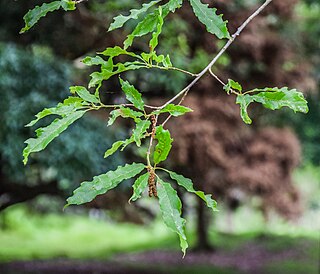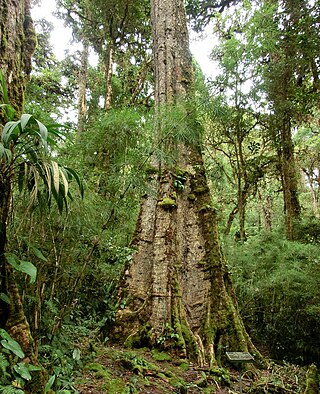
The oncilla, also known as the northern tiger cat, little spotted cat, and tigrillo, is a small spotted cat ranging from Central America to central Brazil. It is listed as Vulnerable on the IUCN Red List, and the population is threatened by deforestation and conversion of habitat to agricultural land.
Magnolia guatemalensis is a tree found in the highlands and mountains of Chiapas, Guatemala, El Salvador, and Honduras. It is considered an indicator species of the cloud forest.

The snowcap is a species of hummingbird in the "emeralds", tribe Trochilini of subfamily Trochilinae. It is found in Costa Rica, Honduras, Nicaragua, and Panama.

Quercus lancifolia is a species of oak found in Central America and Mexico.

The Talamancan montane forests ecoregion, in the tropical moist broadleaf forest biome, are in montane Costa Rica and western Panama in Central America.

The tawny-breasted myiobius or tawny-breasted flycatcher is a species of passerine bird in the family Tityridae. It is found in Bolivia, Colombia, Ecuador, Panama, Peru, and Venezuela. Its natural habitat is subtropical or tropical moist montane forests.

Dice's cottontail is a species of cottontail rabbit in the family Leporidae. It is found in Costa Rica and Panama, in páramo and cloud forest habitats.
Ilex pallida is a species of plant in the family Aquifoliaceae. It is found in El Salvador, Honduras, Nicaragua, Costa Rica, and Panama. It is threatened by habitat loss.
Magnolia panamensis is a species of flowering plant in the family Magnoliaceae. It is native to Panama, and its distribution probably extends into Costa Rica. It is a forest tree with few current threats to its populations.

Quercus benthamii is a species of oak in the family Fagaceae. It is native to cloud forests of Central America and southern Mexico. It is threatened by habitat loss.
Magnolia poasana is a sub-tropical to tropical, subcanopy tree, growing in areas of montane rainforest. The names "Poas", and "poasana" originate from the Poás Volcano in Costa Rica where, along with Panama, they grow in the wild. First described by Henri François Pittier in 1910, it was later described and included in Magnolia by James Edgar Dandy (1927).

Werauhia williamsii is a species of flowering plant in the genus Werauhia. It is a terrestrial bromeliad, native the montane forests of Costa Rica and western Panama.

Quercus insignis is a Mesoamerican species of oak in the white oak section, within the beech family. It is native to southern Mexico and Central America, from Veracruz to Panamá.

Quercus sapotifolia is a species of oak. It is native to southern and western Mexico as well as Central America. It is threatened by habitat loss.
Cornus peruviana is a species of tree in the family Cornaceae native to montane forests of southern Central America and western South America, from Costa Rica and Venezuela south to Bolivia.
Quercus cortesii is a species of oak native to Central America and southern Mexico.
Magnolia pugana, commonly known as almacasusco, is a species of Magnolia from northern Jalisco and southern Zacatecas states in western Mexico.

Cornus disciflora is a species of flowering plant native to Mexico and Central America.
Magnolia tamaulipana is a species of plant in the family Magnoliaceae. It is endemic to northeastern Mexico.
Magnolia sororum is a species of flowering plant in the family Magnoliaceae. It is commonly known as vaco. It is native to the mountain forests of Costa Rica and western Panama, and may range into Nicaragua.











